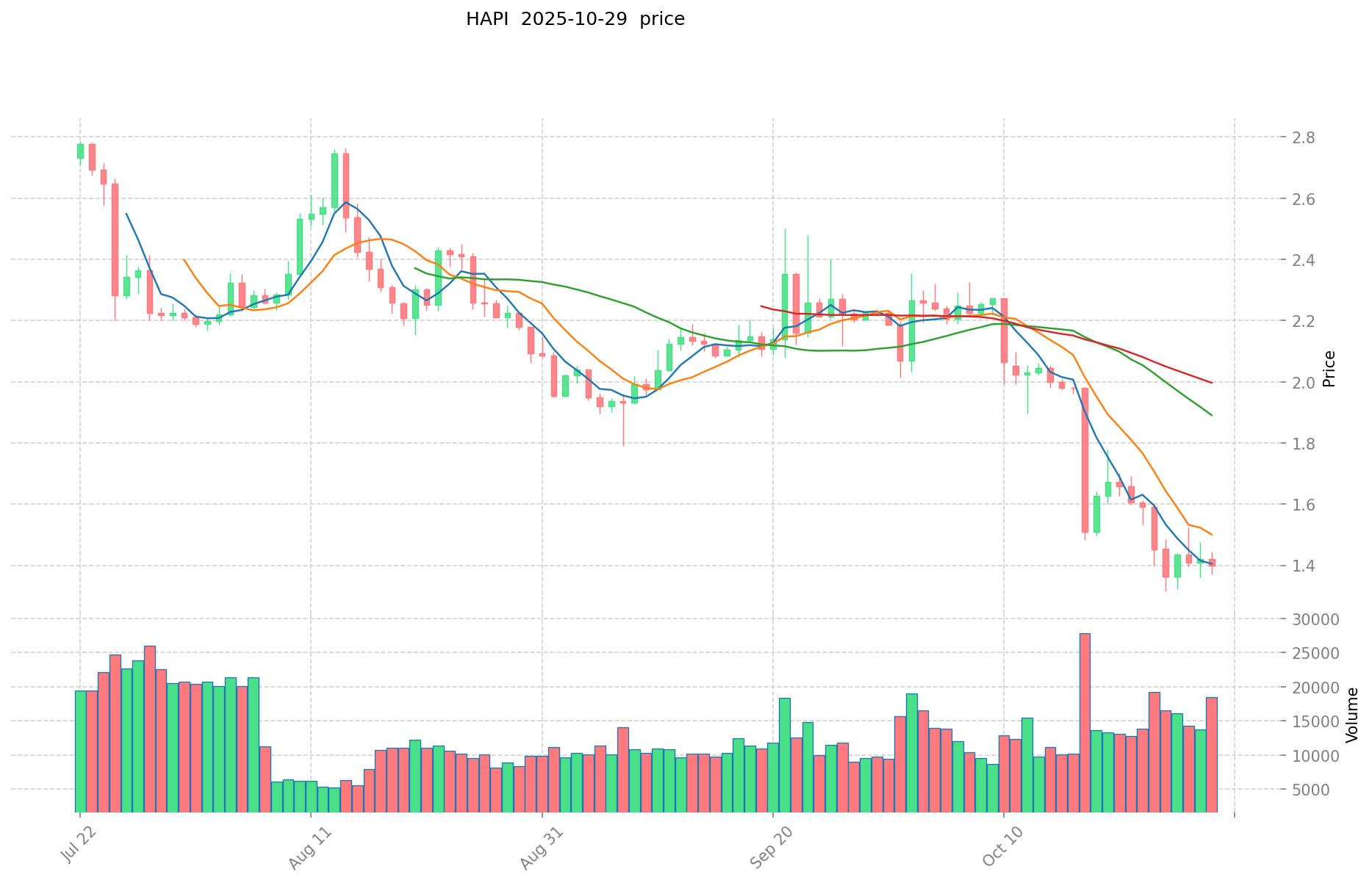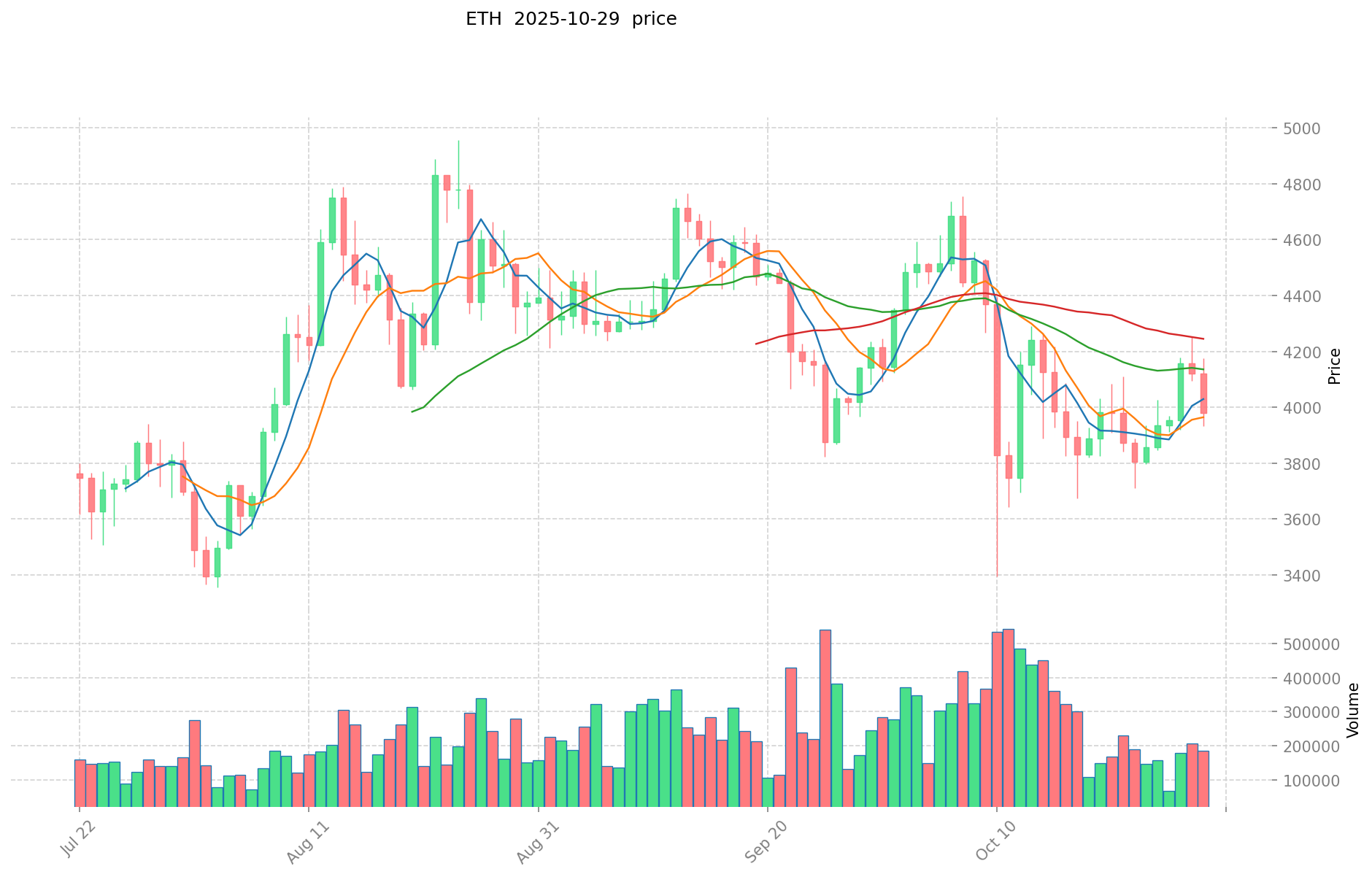HAPI vs ETH: A Comparative Analysis of Two Blockchain Ecosystems
Introduction: HAPI vs ETH Investment Comparison
In the cryptocurrency market, HAPI vs ETH comparison has always been a topic that investors cannot avoid. The two not only have significant differences in market cap ranking, application scenarios, and price performance, but also represent different crypto asset positioning.
HAPI (HAPI): Since its launch in 2021, it has gained market recognition for its cross-chain smart contracts embedded in DeFi products to enhance security.
Ethereum (ETH): Since its inception in 2015, it has been hailed as the foundation for decentralized applications and smart contracts, and is one of the cryptocurrencies with the highest global trading volume and market capitalization.
This article will provide a comprehensive analysis of the investment value comparison between HAPI and ETH, focusing on historical price trends, supply mechanisms, institutional adoption, technological ecosystems, and future predictions, attempting to answer the question investors care most about:
"Which is the better buy right now?"
I. Price History Comparison and Current Market Status
HAPI and ETH Historical Price Trends
- 2021: HAPI reached its all-time high of $200.39, likely due to increased interest in DeFi security solutions.
- 2022: ETH underwent a significant transition with The Merge, shifting to Proof-of-Stake, impacting its price dynamics.
- Comparative Analysis: During the recent bear market, HAPI dropped from its peak of $200.39 to a low of $1.35, while ETH showed more resilience, maintaining a higher market cap and liquidity.
Current Market Situation (2025-10-29)
- HAPI current price: $1.392
- ETH current price: $4006.59
- 24-hour trading volume: HAPI $30,033.80 vs ETH $693,874,234.08
- Market Sentiment Index (Fear & Greed Index): 51 (Neutral)
Click to view real-time prices:
- Check HAPI current price Market Price
- Check ETH current price Market Price


Investment Value Analysis: HAPI vs ETH
Core Factors Influencing HAPI vs ETH Investment Value
Technology Development and Ecosystem Building
- ETH: Continuing upgrades including the upcoming Fusaka hard fork, which improves scalability, efficiency, and security through increased block gas limits, expanded "blob" capacity, and new node security features
- HAPI: Limited information available on technology development
- Ecosystem comparison: Ethereum maintains a robust ecosystem for DeFi, NFTs, payments, and smart contracts, while facing competition from Solana and other Layer 1 solutions
Network Development and Adoption
- ETH: Ethereum maintains position as the leading smart contract platform with ongoing development of Layer 2 solutions
- HAPI: Insufficient data on network metrics or adoption rates
- Market dynamics: Transaction fee distribution among Layer 1 blockchains has shifted significantly, with Solana's fee share dropping from over 50% to 9%, while competitors like Hyperliquid and BNB Chain have gained market share
Market Trends and Economic Factors
- ETH: Price influenced by broader market sentiment, interest rate changes, inflation, and geopolitical events
- Price projections: Technical analysis suggests ETH could reach $5,000 by the end of 2025 and potentially $8,000-$12,500 by 2030
- Market sentiment: Both assets subject to overall crypto market cycles and investor psychology
Technological Innovations and Upgrades
- ETH: Upcoming Fusaka upgrade includes key improvements like EIP-7594 (introducing PeerDAS for better data availability), EIP-7702 (enhancing basic accounts), EIP-7251 (increasing validator balance limits), and EIP-7691 (doubling block space for blob data)
- ETH: Development focus on improving scalability while maintaining decentralization
- Competitive landscape: ETH faces competition from more scalable solutions like Solana, which focuses on transferring costs to DApp teams and infrastructure providers rather than end users
III. 2025-2030 Price Prediction: HAPI vs ETH
Short-term Prediction (2025)
- HAPI: Conservative $1.29 - $1.39 | Optimistic $1.39 - $1.67
- ETH: Conservative $3,324 - $4,005 | Optimistic $4,005 - $5,287
Mid-term Prediction (2027)
- HAPI may enter a growth phase, with estimated prices ranging from $0.88 to $1.80
- ETH may enter a bullish market, with estimated prices ranging from $2,885 to $6,588
- Key drivers: Institutional capital inflow, ETF, ecosystem development
Long-term Prediction (2030)
- HAPI: Base scenario $1.34 - $2.16 | Optimistic scenario $2.16 - $3.18
- ETH: Base scenario $5,979 - $6,953 | Optimistic scenario $6,953 - $8,343
Disclaimer: The above predictions are based on historical data and market analysis. Cryptocurrency markets are highly volatile and subject to rapid changes. These forecasts should not be considered as financial advice or guarantees of future performance.
HAPI:
| 年份 | 预测最高价 | 预测平均价格 | 预测最低价 | 涨跌幅 |
|---|---|---|---|---|
| 2025 | 1.6692 | 1.391 | 1.29363 | 0 |
| 2026 | 1.805518 | 1.5301 | 1.162876 | 9 |
| 2027 | 1.80123372 | 1.667809 | 0.88393877 | 19 |
| 2028 | 2.0120447776 | 1.73452136 | 1.127438884 | 24 |
| 2029 | 2.454000820128 | 1.8732830688 | 1.31129814816 | 34 |
| 2030 | 3.18055365836208 | 2.163641944464 | 1.34145800556768 | 55 |
ETH:
| 年份 | 预测最高价 | 预测平均价格 | 预测最低价 | 涨跌幅 |
|---|---|---|---|---|
| 2025 | 5286.8904 | 4005.22 | 3324.3326 | 0 |
| 2026 | 4971.279064 | 4646.0552 | 3205.778088 | 15 |
| 2027 | 6587.87397084 | 4808.667132 | 2885.2002792 | 20 |
| 2028 | 7236.8036003034 | 5698.27055142 | 3874.8239749656 | 42 |
| 2029 | 7437.667637240955 | 6467.5370758617 | 4915.328177654892 | 61 |
| 2030 | 8343.122827861593 | 6952.6023565513275 | 5979.23802663414165 | 73 |
IV. Investment Strategy Comparison: HAPI vs ETH
Long-term vs Short-term Investment Strategies
- HAPI: Suitable for investors focused on DeFi security solutions and niche market potential
- ETH: Suitable for investors seeking ecosystem stability and long-term growth potential
Risk Management and Asset Allocation
- Conservative investors: HAPI: 5% vs ETH: 95%
- Aggressive investors: HAPI: 20% vs ETH: 80%
- Hedging tools: Stablecoin allocation, options, cross-currency portfolio
V. Potential Risk Comparison
Market Risk
- HAPI: Higher volatility due to lower market cap and trading volume
- ETH: Subject to broader crypto market trends and macroeconomic factors
Technical Risk
- HAPI: Scalability, network stability
- ETH: Network congestion, high gas fees during peak usage
Regulatory Risk
- Global regulatory policies may impact both assets differently, with ETH likely facing more scrutiny due to its larger market presence
VI. Conclusion: Which Is the Better Buy?
📌 Investment Value Summary:
- HAPI advantages: Niche focus on DeFi security, potential for growth in specialized market
- ETH advantages: Established ecosystem, ongoing technological improvements, strong network effects
✅ Investment Advice:
- New investors: Consider allocating a larger portion to ETH for stability and growth potential
- Experienced investors: Diversify with a mix of ETH and HAPI, adjusting based on risk tolerance
- Institutional investors: Focus on ETH for liquidity and market depth, with potential small allocation to HAPI for portfolio diversification
⚠️ Risk Warning: Cryptocurrency markets are highly volatile. This article does not constitute investment advice. None
VII. FAQ
Q1: What are the main differences between HAPI and ETH? A: HAPI is focused on cross-chain smart contracts for DeFi security, while ETH is a broader platform for decentralized applications and smart contracts. ETH has a much larger market cap, higher trading volume, and more established ecosystem compared to HAPI.
Q2: Which has performed better historically, HAPI or ETH? A: ETH has shown more resilience and stability in price performance. During the recent bear market, HAPI dropped from its peak of $200.39 to a low of $1.35, while ETH maintained a higher market cap and liquidity.
Q3: What are the key factors influencing the future price of ETH? A: Key factors include ongoing technological upgrades (like the upcoming Fusaka hard fork), ecosystem development, institutional adoption, market sentiment, and broader economic factors such as interest rates and inflation.
Q4: Is HAPI or ETH considered a better long-term investment? A: ETH is generally considered a more stable long-term investment due to its established ecosystem, ongoing development, and stronger network effects. However, HAPI may offer higher growth potential in its niche market of DeFi security solutions.
Q5: How do the 2030 price predictions compare for HAPI and ETH? A: For 2030, HAPI's base scenario predicts a range of $1.34 - $2.16, with an optimistic scenario of $2.16 - $3.18. ETH's base scenario predicts $5,979 - $6,953, with an optimistic scenario of $6,953 - $8,343.
Q6: What allocation strategy is recommended for conservative investors? A: For conservative investors, a suggested allocation is 5% HAPI and 95% ETH, focusing more on the established and relatively stable ETH market.
Q7: What are the main risks associated with investing in HAPI and ETH? A: For HAPI, main risks include higher volatility due to lower market cap, potential scalability issues, and network stability. For ETH, risks include network congestion, high gas fees during peak usage, and potential regulatory scrutiny due to its larger market presence.
Share
Content